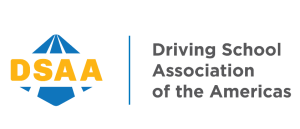Designated Lane of Travel
Divided Highways
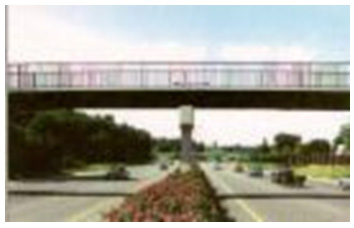 A divided highway is a highway a where a wall or retainer is dividing the traffic driving in opposite directions.
A divided highway is a highway a where a wall or retainer is dividing the traffic driving in opposite directions.
Lane Roadways
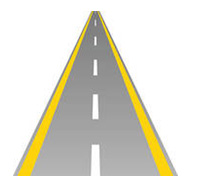 A lane roadway is a roadway where there are at least two clearly marked lanes for traffic, going in one direction on the roadway.
A lane roadway is a roadway where there are at least two clearly marked lanes for traffic, going in one direction on the roadway.- The lane has either a double yellow line, or single yellow line in the center.
- The lines can be broken or unbroken.
Three-Lane Highways
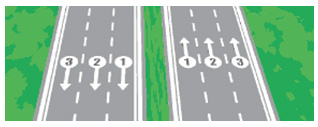
- These highways have three lanes of traffic all going in the same direction of travel.
- The left or “fast” lane is called the “Number one lane,” the lanes to the right of the number one lane are called the number two and then the number three lanes. Drive in the lane with the smoothest flow of traffic. If you can choose among three lanes, pick the middle lane for the smoothest driving. To drive faster, pass, or turn left, use the left lane. When you choose to drive slowly or enter or exit the road, use the right lane.
HOV Lanes
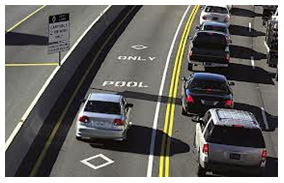 The HOV lanes, or high occupancy vehicle lane(s) are also known as the carpool lanes. These lanes are clearly
The HOV lanes, or high occupancy vehicle lane(s) are also known as the carpool lanes. These lanes are clearly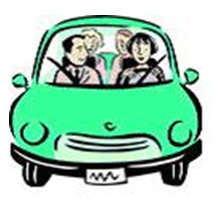 marked and are restricted to vehicles with two (and sometimes three) or more occupants.
marked and are restricted to vehicles with two (and sometimes three) or more occupants.
Position of Vehicle on Lane of Travel
Marked Lanes
- The position of the vehicle in a marked lane is to the right side of your lane or in the center if there are two lanes. You want to stay in the center of your lane of travel.
Narrow Roadways
- Position your vehicle to the far right of a narrow roadway and reduce your speed.
Mountain Roadways
- Position your vehicle to the extreme right of the roadway while driving on a mountain or curved roadway.
- Use your headlights.
- Honk your horn on blind curves.
Other Vehicles Approaching
- When a car or vehicle is approaching you from the opposite direction or to pass you on the roadway, it is important to move your vehicle to the far right of your lane.
Exceptions to Driving on the Right Side of Roadway
When passing a vehicle going in your direction, you will end up crossing over onto the opposing traffic’s lane of travel. Extreme caution must be used. On a multi-lane highway, you will also be using the left lane within the same direction to pass a vehicle.
The following are exceptions to driving on the right side of the roadway:
- When turning left at an intersection, a cross street or a private roadway.
- When the right half of the road is closed or blocked.
- On a one-way roadway.
- When the road is not wide enough.
- When weather conditions and road markings force you too.
Required Lane Use and Use of Turnouts
Left turn lanes are to be used when turning left from a highway. This keeps traffic flowing and minimizes rear-end collisions. Turnout lanes are usually provided on a single-lane mountain and country roads to allow slower vehicles to pull over allowing lighter, faster traffic to pass safely. It is required for vehicles traveling slower than the other vehicles to use turnouts when five or more cars are behind you and allow traffic to clear before proceeding.
Slow-Moving Vehicles
- Any vehicle upon a highway traveling less than the normal speed of traffic moving in the same direction shall drive in the right-hand lane except when over taking and passing another vehicle traveling in the same direction.
Left Turns
- Use left turn lanes when preparing for lefts turn at an intersection, cross road or private roadway.
Use Turnouts When Five Cars Are Behind You
- It is required for vehicles that are traveling slower than the other vehicles (5 vehicles) traveling on the same road in the same direction to use the designated turnouts, and allow traffic to clear before proceeding.
Special Vehicles
- On three and four-way highways in California, large trucks are restricted to the two right lanes. They generally travel in the far right lane and use the second lane to pass.


